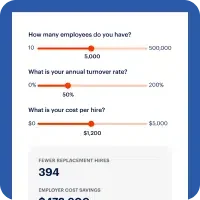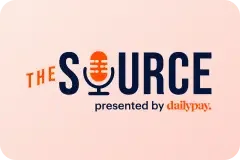Onboarding comes with its fair share of HR heavy lifting, which includes distributing and collecting W-4 forms and entering that information into your payroll system.
But this simple act comes loaded with hazards that you should be aware of.
Today we’ll review some obvious and not-so-obvious considerations with regard to the W-4.
First, what is a W-4?
The Form W-4 is a form that tells an employer the proper amount to withhold from an employee’s paycheck for federal income tax.
Withholding tax (also known as “payroll withholding”) is essentially income tax that is withheld from employees’ wages and sent directly to the IRS by an employer. By subtracting this money from each paycheck, the IRS is more or less withholding anticipated tax payments as they are earned.
In general, if an employee elects for lower payroll withholding, they will owe more in income taxes at the end of the fiscal year. The higher the payroll withholding, the lower the end-of-year taxes, which might end up in a refund.
When must a W-4 be completed?
Before the first paycheck. There will be no withholding until the employee turns it in.
What would make a Form W-4 invalid?
If any of the required information is missing and/or a signature is not provided.
Deleting or altering official language on the form also invalidates it.
Also, a Form W-4 will be invalid if an employee indicates in any way that it is false (i.e., they lie or fill out something incorrectly).
What if I can’t tell if it’s invalid?
It’s really not black and white all the time.
According to the Treasury Regulations, you should reject a Form W-4 if:
“…the employee clearly indicates [that the W-4 is] false by an oral statement or by a written statement other than the W-4 itself.”
A W-4 is also invalid if it contains an unauthorized alteration or addition.
What’s an “alteration or addition,” exactly?
Here’s a handy definition. Rather than “alter” it (i.e., translate from IRS to English), we’ll keep compliant and you can just mentally substitute the word “instrument” for “W-4” so the definition is both germane and sensical.
“Alteration” means (i) an unauthorized change in an instrument that purports to modify in any respect the obligation of a party, or (ii) an unauthorized addition of words or numbers or other change to an incomplete instrument relating to the obligation of a party.
What do I do with an invalid form?
Don’t use it!
Ask the employee to fill it out again, this time correctly.
If you can’t squeeze a valid form out of them, you should withhold taxes as if the employee were single and claiming no withholding allowances.
If you already have a valid Form W-4 on file for that employee, then simply withhold in accordance with the previous form.
When does a new W-4 go into effect?
Employers must implement a new W-4 by the start of the first payroll period ending on or after the 30th day from the date the employer receives.
So let’s say your new hire gets their W-4 in on time on the 4th of the month. Payday happens on the 15th and the 30th every month.
The W-4 must be implemented by the 15th-of-the-month payroll, no later. Earlier is fine!
Can I speed things along and do it for them?
Nope. That’s illegal. Thanks for asking. We admire your diligence.
If an employee is having a tough time with the W-4, direct them to this IRS article about Calculating Your Withholding Allowance.
How often can an employee change a W-4?
Any time and as often as they want!
But you have to get all updated W-4s in before the next payroll. The most current W-4 must be signed by the employee and kept in the employee’s payroll folder to verify the amount of federal income tax withholding.
How often do they need to update their W-4s?
- Get married
- Get divorced
- Gain or lose dependents
- Buy a new house
- Retire
- Increase or decrease income not subject to withholding, such as dividends, interest or capital gains
- Increase or decrease itemized deductions or credits, such as job expenses or education credits.
Otherwise, they can fill it out once and they’re good to go. There’s no expiration date.
If/when they leave your company, the W-4 continues in effect for withholding of FICA taxes for payments made after their last day.
Can I accept W-4 forms by phone or email?
Nope.
Changes can only be made by completing and signing the W-4 form itself in person, by mail, or via IRS-compliant electronic systems. Many states issue their own variations of the W-4 for state income withholding, and some states don’t allow electronic submissions. So remember to verify whether your state is one of those.
What about copies or scans?
Nope.
The IRS requires that you have original copies on hand for each employee for at least four years after the date the employment tax becomes due or is paid (whichever is later). When requested, you must make original Forms W-4 available for inspection by an IRS employee.
What if an employee submits a Form W-4 that results in less taxes being withheld than is required?
They could get in trouble, with up to a $500 fine.
What if any employee submits a Form W-4 that eliminates all withholding requirements?
In that case, the employee needs to verify that they were entitled to a full refund of all income taxes withheld the previous year and prove a viable expectation of no tax liability for the coming year.
If there are no red flags, then that lucky, tax-free employee needs to fill out a new W-4 every February 15th, which is when exemption status is renewed or retracted.
What do I do if I get something called a “lock-in” letter from the IRS?
Immediately give a copy of the lock-in letter to the employee. Ignore the current W-4 and any future W-4s and follow the IRS’s withholding instructions. When/if the employee leaves, fax a signed note on company letterhead to let the IRS know.
Importantly, don’t let the employee try to increase allowances. If you fail to maintain the lock-in letter’s specified withholding amount, you could be penalized and even be liable for the amount of tax that should have been withheld.













